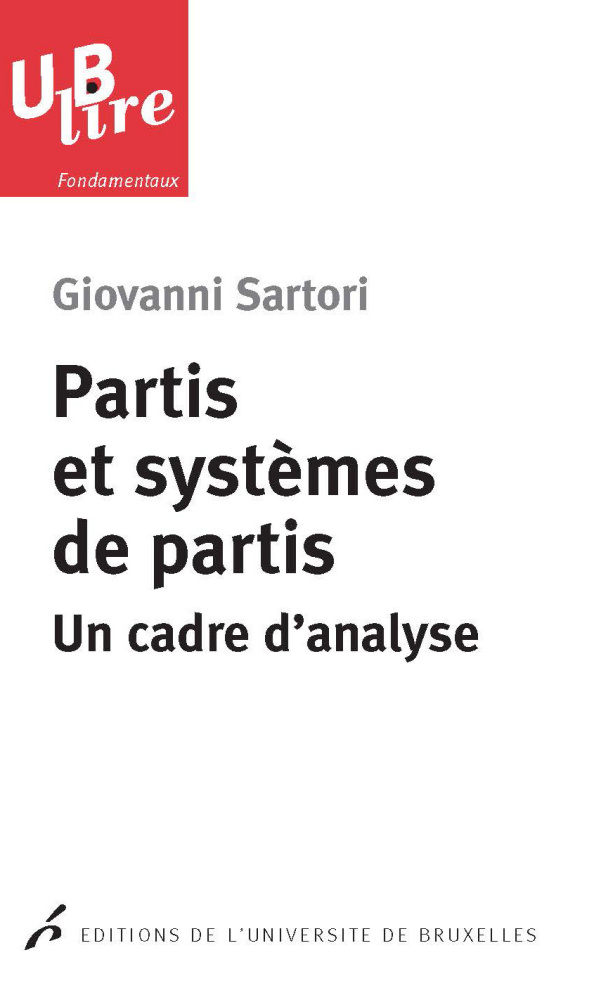Downloads
Partis et systèmes de partis
Un cadre d’analyse
First Edition
Translated by Paul-Louis van Berg
Le livre de Giovanni Sartori sur les partis politiques et les systèmes de partis est aujourd’hui l’un des plus grands classiques de la littérature politologique. Sa traduction en français comble une énorme lacune. Read More
Dans cet ouvrage fondé sur une méthodologie rigoureuse et un matériau empirique d’une exceptionnelle richesse, Giovanni Sartori analyse l’histoire des partis, leurs définitions possibles et, surtout, les relations qu’ils nouent entre eux pour former un système de partis.
Publié une première fois en 1976, ce chef-d’œuvre dans l’étude des partis reste une, sinon la référence incontournable sur la question.
Specifications
- Publisher
- Éditions de l'Université de Bruxelles
- Author
- Giovanni Sartori,
- Introduction by
- Peter Mair,
- Translated by
- Paul-Louis van Berg,
- Collection
- UBlire | n° 10
- ISSN
- 20321287
- Language
- French
- Publisher Category
- Publishers own classification > Political Science
- BISAC Subject Heading
- POL015000 POLITICAL SCIENCE / Political Process / Political Parties
- Onix Audience Codes
- 06 Professional and scholarly
- CLIL (Version 2013-2019)
- 3283 SCIENCES POLITIQUES
- Subject Scheme Identifier Code
- Thema subject category: Political parties and party platforms
Paperback
- Publication Date
- 17 January 2011
- ISBN-13
- 978-2-8004-1462-1
- Extent
- Main content page count : 528
- Code
- 1462
- Dimensions
- 110 x 180 x 22 cm
- Weight
- 336 grams
- ONIX XML
- Version 2.1, Version 3
Google Book Preview
Review
- Source
- Camille Bedock
- https://www.cairn.info/revue-francaise-de-science-
" [...] la raison pour laquelle il faut lire et relire Sartori en 2013 est aussi ailleurs, et réside dans l'approche intellectuelle qu'il défend : un fort réquisitoire en faveur de taxinomies fondées sur des bases conceptuelles solides, cohérentes, confrontant des objets véritablement comparables parce que clairement définis. Tout au long de l’ouvrage, G. Sartori fustige les approximations terminologiques et conceptuelles qui brouillent la réalité et en empêchent la compréhension.
...more
Contents
- NOUVELLE PRÉFACE DE L’AUTEUR
- INTRODUCTION – Partis et systèmes de partis | Peter MAIR
- PRÉFACE
- PREMIÈRE PARTIE – LA RAISON D’ÊTRE : POURQUOI DES PARTIS
- CHAPITRE I – Le parti en tant que partie
- 1. De la faction au parti
2. Le pluralisme
3. Gouvernement responsable et redevable
4. Une rationalisation
- CHAPITRE II – Le parti en tant que tout
- 1. De l’absence de parti au parti unique
2. Le système de l’État-parti
3. Pluralisme du parti unique
- CHAPITRE III – Le cadre préliminaire
- 1. Canalisation, communication, expression
2. La définition minimale
3. Vue d’ensemble
- CHAPITRE IV – Le parti vu de l’intérieur
- 1. Fractions, faction et tendances
2. Un schéma d’analyse
3. Politique sudiste : « factions » sans partis ?
4. Italie et Japon : des fractions à l’intérieur des partis
5. La structure des opportunités
6. Du parti à la faction
- DEUXIÈME PARTIE – LES SYSTÈMES DE PARTIS
- CHAPITRE V – Le critère numérique
- 1. Le problème
2. Des règles de comptage
3. Une tabulation à deux dimensions
- CHAPITRE VI – Systèmes compétitifs
- 1. Pluralisme polarisé
2. Évaluation de cas
3. Pluralisme modéré et sociétés segmentées
4. Systèmes bipartites
5. Systèmes à parti prédominant
- CHAPITRE VII – Systèmes non compétitifs
- 1. Quand la compétition se termine
2. Le parti unique
3. Le parti hégémonique
- CHAPITRE VIII – Organisations politiques fluides et quasi-partis
- 1. Précautions méthodologiques
2. Le dédale africain
3. Faire des catégories ad hoc
4. L’effet boomerang
- CHAPITRE IX – Le cadre global
- 1. Changement du système, continuum et discontinuités
2. Fonction de tabulation et pouvoir explicatif
3. De la classification à la mesure
4. Mesurer la pertinence
5. Nombres et taille : l’indice de fragmentation
6. Combinaison des voies nominale et mathématique
- CHAPITRE X – La compétition spatiale
- 1. La théorie de Downs revisitée
2. Enjeux, identification, images et positions
3. Espace multidimensionnel, unidimensionnel et idéologique
4. La direction de la compétition
- Liste des abréviations
- Liste des tableaux et des figures
- Index


Review
Nombreux sont ceux à penser que son œuvre majeure est cet ouvrage écrit en 1976. […]
Que cet immense classique de la littérature politologique soit pour la première fois publié en langue française est donc une aubaine pour tous ceux qui, à un titre ou à un autre, cherchent à comprendre et cerner l'histoire des partis politiques, leurs définitions possibles et, surtout, les relations qu’ils nouent entre eux pour former un systèmes de partis."